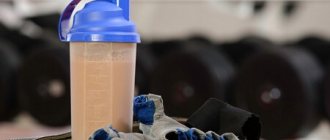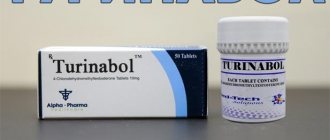Creatine is a nitrogen-containing organic compound (acid) that takes part in a set of metabolic reactions with the release of energy. In bodybuilding, creatine has become widespread as a means of increasing strength, building muscle mass and increasing anaerobic endurance with proven complete safety for the body. Such a capacious formulation, of course, brings us up to date, but still does not give a complete picture of what is happening, so we will look into it in more detail.
Introduction
Creatine has earned high popularity in sports due to its simplicity and effectiveness. Despite the fact that its composition is not replete with the presence of all kinds of proteins, fats, carbohydrates, vitamins and other microelements, its effectiveness is so high that it is used not only in fitness and bodybuilding, but in almost all aerobic and anaerobic sports, from skiing and cycling racing, to weightlifting and powerlifting. Earlier, in the article “What is sports nutrition,” we described in general terms the main properties, harms and benefits of creatine. Now it's time to understand in detail what it is.
Thanks to its effective and at the same time incredibly simple composition, this supplement is truly universal, due to which creatine for gaining muscle mass and creatine for weight loss are often the same product. That is, with it you can both gain and lose weight.
IMPORTANT. This article is based on materials from the book by the author Davidenko F. Yu. “ PROFILES OF ANABOLISM” .
Creatine in sports
Creatine supplements are popular in strength sports. Indeed, this is a godsend for a bodybuilder who likes bulky muscles and just wants to look big. There is an opinion among bodybuilders that creatine can be used constantly while bulking, and at the very beginning of cutting, too, in order to maintain the speed of metabolic reactions.
But athletes who need to stay within a weight class are not very fond of creatine. It is known from practice that with the help of creatine supplements you can gain 2-3 kg of weight. Again, after stopping creatine, this weight quickly disappears, but many people don’t like the idea of gaining weight, so they are against creatine supplements.
In strength sports and bodybuilding, creatine promotes:
- Rapid muscle pumping, this is especially noticeable when taken together with arginine;
- Mass growth;
- When used together with selective androgen receptor modulators – acceleration of anabolic processes and a significant increase in strength;
- When used “solo” - an increase in strength indicators for the duration of use;
- Overcoming the “power plateau”;
- Accelerating metabolism by gaining muscle mass;
- Increasing the efficiency of the heart;
- Glycogen binding and more efficient muscle function;
Performance boost
You can find information that creatine increases performance by 35%, which contributes to both strength and endurance. Moreover, the effects of creatine are not directly anabolic and therefore do not affect the athlete’s hormonal system.
It works indirectly. Creatine retains water, muscles plump up faster. This requires more oxygen consumption, improves blood circulation and muscle nutrition. As a result, a person breaks through a strength plateau. It turns out that the pumping effect helps to overcome a strength plateau and a plateau in endurance due to creatine.
Muscle pumping itself promotes:
- Increased oxygen supply;
- Glycogen retention
Creatine thus helps indirectly increase strength endurance. The normal effect of taking it is that the athlete learns to overcome heavy loads in a multi-repetition mode. Thus, working weights can increase from 50% to 60-70 of 1 RM in basic exercises. Over time, this leads to an increase in the athlete’s fitness and strength indicators.
Conclusion: creatine does not affect the human hormonal system. It is also not a selective androgen receptor modulator. It simply promotes the retention of glycogen and water in the muscles, which mechanically increases their performance. Creatine helps you become stronger and more resilient, but all this happens with an increase in the athlete's own weight.
"Filling" with water
Many bodybuilders specifically drink salty mineral water and increase the salt content in their diet during the off-season. This should promote greater endurance and strength, and serve as a means of injury prevention. Creatine works in much the same way. Its “mission” is to retain water. In the offseason, this could be promising in terms of injury prevention.
Important: “filling with water” also improves the biomechanical characteristics of the muscles, and therefore serves as a good way to prevent injuries resulting from poor technique.
“Filling” can also have side effects. It is a common cause of cramps, as an imbalance of mineral salts and water is created in the body. When performing heavy approaches in this condition, the athlete should always use the help of a spotter. The problem with cramps is solved by additional consumption of potassium and magnesium, but this also leads to a slight decrease in the amount of water in the muscles.
Increasing the amount of fluid in the muscles is considered beneficial, but it must be borne in mind that this point is not suitable for those who have problems with kidney health and high blood pressure.
Muscle growth
So, creatine starts the process of increasing the supply of blood and oxygen to the muscles. With adequate training loads, its use will also contribute to the growth of muscle mass. Creatine “gains mass” only when all conditions for normal protein synthesis are present. The athlete must eat normally and recover. Otherwise, creatine will be a useless supplement. These are not anabolic steroids to correct lack of regimen, lack of nutrition and too heavy, incorrectly selected training programs.
The work of creatine can be schematically represented as follows:
- When loading it in the muscles, fluid retention also occurs;
- A muscle pump leads to increased oxygen consumption and increased blood circulation;
- Amino acids that enter the body through nutrition are used for muscle growth;
- Anabolic processes are also supported by the partial resynthesis of creatine into amino acids;
- When increasing strength indicators, this scheme works better
So, creatine really helps you recover faster and build muscle. What about other sports indicators?
Maestro Pain about creatine
Creatine and kickback
This substance is deservedly “disliked” by beginners who became acquainted with the phenomenon of creatine withdrawal too early. What it is? Over time, the substance accumulates in tissues, and all metabolic processes are concentrated on its removal. The body stops accepting creatine and simply tries to get rid of its excess. There is no point in drinking more. The athlete must stop taking it.
When you stop taking creatine, the following happens:
- The substance accumulated in the muscles is removed from the body;
- The liquid retained by it is “drained”;
- The body no longer looks the same - the muscles become flatter;
- Endurance indicators drop;
- Pumping disappears
Important: recovery from creatine is never complete. If you compare dry mass indicators before and after a course of creatine, they will differ.
It is advisable to cycle creatine intake according to your training plan. That is, when an athlete reaches the peak of strength, creatine supports his efforts. Then, when the reception stops, the athlete reduces the volume and intensity of the load and rests.
Creatine and bone density
Athletes supplementing with calcium and D3 may benefit from taking creatine. It serves as an indirect transport of these substances, which means that with its intake the bones are also strengthened.
Bone density is a value that depends on the athlete’s muscle mass. If muscles grow at a fairly slow, physiologically natural rate, as happens with creatine, the athlete receives stronger bones in addition to improved body quality. This allows him to be more protected from injury.
Creatine supplementation is therefore advisable in sports where there is a high level of impact and injury. There he is adjusted to the off-season, in which the athlete is engaged in general physical training.
Description of the additive
Substance: creatine
Description: white crystalline powder. Colorless, tasteless and poorly soluble in water.
Objectives: used in sports to increase strength and muscle mass.
Ingredients: Typical ingredients will be listed below on the product label.
Indications: Due to the enhancement of strength indicators, creatine is widely used in sports in general. Both in individual sports (martial arts) and in team sports (basketball, football, hockey). It is most widely used, of course, among bodybuilders.
Contraindications: not recommended for use by adolescents before the end of puberty - boys under 19-20 years old, girls under 16-17 years old.
Side effects: Digestive problems may occur as a result of excessively exceeding the recommended dosages of creatine. To prevent this effect, micronized forms of powder have been developed that do not cause such reactions. Cramps and spasms occur extremely rarely and their connection with creatine consumption has not been directly proven. But indirectly, they can be caused by electrolyte imbalances due to insufficient water intake while taking the supplement. That is, cramps and spasms can be a consequence of ordinary dehydration.
ADVICE. One of the main functions of creatine is to retain water in the body. As a result, during the period of taking creatine, the rate of water consumption should not be lower than the recommended one. Taking the supplement with low water consumption can lead to dehydration, which in turn disrupts metabolism, heat regulation and acid-base balance. In this regard, we strongly recommend that you read the article “The Role of Water in Diet and Exercise,” in which we described not only the functions of water in the body and the importance of its consumption, but also provided a table for calculating the daily norm of its consumption.
Interaction: with a properly formulated regimen, it can be combined with other types of sports supplements.
Directions for use: orally.
Overdose: Multiple studies have proven that taking creatine is absolutely safe for the body. With an average dosage of 10 grams per day, an overdose of even 25 grams per day does not lead to any consequences.
Release form: micronized powder, capsules, tablets, liquid.
Types: creatine monohydrate, chelate, malate, citrate, phosphate, hydrochloride, crealkaline, ethyl ester, complex creatine, etc.
Production method: Creatine is produced from sarcosine, a substance that is artificially obtained from the final product of the reaction of monochloroacetic acid and methylamine.
Manufacturers : Optimum Nutrition, Dymatize, Universal Nutrition, Olimp, Ultimate Nutrition, Weider, SAN, MuscleTech, Multipower, etc.
Shelf life: depending on the manufacturer and composition – up to three years, subject to storage conditions.
Storage conditions: store in a cool, dry place, away from direct sunlight.
How does creatine affect the body?
Is creatine needed for normal body function? Modern sources on sports medicine classify it as an essential substance. Creatine affects the following processes in the body:
- "Mobility" of cholesterol. This term refers to the ability to remove “bad” cholesterol and transport “good” cholesterol. Creatine affects the health of the cardiovascular system and can indirectly be considered a means of preventing high blood pressure;
- Increased lactate threshold. The lactate threshold is the body's ability to resist the effects of lactic acid. If you consume creatine, the body's performance will increase due to;
- Fluid retention and binding. This effect applies only to the muscles, and causes a pump during training, and a more “full” appearance after it;
- Improving oxygen supply to white muscle fibers, and, accordingly, improving their performance;
- Improves overall performance during training through fluid retention and improved angles.
Contrary to popular belief, creatine does not help “heal joints” or “fill” them with joint fluid. It only improves metabolic parameters, but does not affect joint health.
What is creatine
This is one of the natural components that is found in human muscles and is necessary for the body for energy metabolism and physical activity. In our body it is present in quantities of about 2 grams per 1 kilogram of weight and acts as a source of energy for muscles. At the same time, creatine consumption per day at a normal pace of life is approximately the same 2 grams. Creatine in its importance is on a par with proteins, fats, carbohydrates, vitamins and minerals. The body is able to synthesize it on its own. But it should be remembered that an active lifestyle and systematic training increase creatine consumption. Therefore, it must be taken as an additional sports supplement.
Now it's time to look at creatine in terms of its different forms. It is worth mentioning in advance that, despite the wide variety of forms of creatine release, most of them (if not all) are absolutely useless and ineffective, which has been repeatedly proven by scientific research. Their popularity, with rare exceptions, is extremely low, and their popularity with the general public is explained only by a well-thought-out marketing campaign. The list of supplement types below will help you sort out the questions - which creatine is better, or which creatine to choose when you have any.
How does creatine work?
Speaking about the principle of operation of creatine, you need to consider the issue from a biochemical point of view and take into account the main energy processes that occur in muscle tissue. The main energy unit in the human body is adenosine triphosphate (ATP molecule), into which all fats, proteins and carbohydrates consumed by a person are converted. The human body uses adenosine triphosphate in places where energy is required (for example, muscle tissue during its active work). As soon as the ATP molecules are delivered to the right place, their breakdown will begin to occur, which will lead to the release of a large amount of energy for the required processes (muscle contraction, synthesis of new muscle fibers, muscle growth, etc.).
When it enters muscle tissue, creatine combines with a phosphate group, resulting in the production of phosphocreatine. Energy metabolism in muscle tissue is ensured by this particular phosphate group: split adenosine triphosphate receives a phosphate group from creatine, restores it and makes it functional.
Creatine allows you to ensure a continuous energy supply to muscle tissue during its work, halves the human body’s costs for the synthesis of adenosine triphosphate and doubles the rate of muscle growth.
Types of Creatine
- Creatine monohydrate. The most common form of creatine supplement. It is also considered the most effective, which has been proven by numerous laboratory studies and tested by many athletes in practice. It is also a kind of experimental basis, on the basis of which other variations of “the same thing” are produced.
- Creatine chelate. A combination of creatine and magnesium molecules. According to the manufacturer, this form of the product should protect creatine from cyclization, which increases its availability for metabolic processes in muscle cells. With this and other declared properties, the effectiveness of the additive itself as a whole remains in doubt.
- Creatine malate. It is a form of the supplement that is better soluble and easier to absorb by the body. Combines molecules of creatine and malic acid (malate). Presumably, this form is more active than the classic monohydrate. The downside is that this form is quite new and has no evidence base.
- Creatine citrate. Combines creatine molecules and citric acid molecules attached to them. Since this acid is a mediator in the chemical processes of energy formation, creatine, when combined with it, should provide the muscles with a significant amount of energy. But only in theory, there is no scientific evidence for this yet.
- Creatine phosphate. A combination of creatine molecules combined with phosphate molecules. Creatine is often found in this form in muscles. Phosphate can neutralize lactic acid, which causes muscle fatigue. Again, despite all the manufacturer’s statements, it has been proven that it is less effective than the classic monohydrate.
- Creatine hydrochloride. The most bioavailable form of creatine, it is easier to absorb than others and therefore does not require significant loading or withdrawal. Supposedly the most potent and soluble form of creatine on the sports supplement market. But despite this, its effectiveness remains in doubt.
- Crealkalin. A combination of creatine and alkali. The presence of alkali in this supplement, according to the manufacturer, makes it possible to neutralize the acidic environment of the stomach and increase the degree of absorption of creatine. Despite these statements, studies have shown that this form is significantly worse than the monohydrate, since its effectiveness is extremely low.
- Creatine ethyl ester. Combination of creatine and ester. The manufacturer claims that the product has good stability and is perfectly absorbed due to the presence of ester in its composition, which facilitates the transport of creatine to cells. Studies have proven that despite these statements, this combination of components is ineffective.
- Complex creatine. A typical manufacturer's marketing ploy is a mixture of all of the above forms of creatine, in the hope that if they do not work individually, they should work together. As a rule, one package contains chelate, malate, citrate, phosphate, ethyl ester and more. You can judge the effectiveness of this form for yourself.
So, material No. 1 (you can call it “Creatine production, version for dummies”☺):
By Chris Belanger
Many bodybuilders are not aware of how the creatine found in sports nutrition products is produced. They have no idea whether they make it from natural or synthetic raw materials. I will reveal this secret a little for them.
Naturally, our body produces creatine from a combination of three amino acids - glycine, arginine and methionine. Creatine is also found in animal foods, but extracting enough creatine from them for commercial use is very impractical, the product would be too expensive (note: although in the early days after the discovery of creatine, it was produced as a supplement from meat).
This begs the question: where does the creatine we use as a supplement come from? It is produced synthetically, from two chemicals - sarcosine and cyanamide (not to be confused with the similar-sounding poison cyanide). Although these substances cannot be called natural, their reaction results in a product that is absolutely suitable for human consumption: creatine. The reaction of sarcosine and cyanamide with a certain amount of water inside a special enamel container (reactor) is the method for producing synthetic creatine.
To illustrate how chemicals can be combined to produce a product fit for human consumption, let's look at common table salt. The sodium and chlorine that it consists of are completely impossible to consume in their original form. The same chlorine is extremely poisonous, it was even used as a chemical weapon during the First World War. But as a result of a chemical reaction from chlorine and sodium, we get a new harmless food component - traditional table salt.
The production process of creatine monohydrate occurs in 4 stages:
- Chemical reaction
- Cleaning
- Drying
- Grinding
Upon completion of these steps, creatine monohydrate is ready for packaging.
Original source of material
Material No. 2: fragment of the book “Creatine and Creatine Kinase in Health and Disease”, 2008.
Authors of the book chapter used: Ivo Pischel, Thomas Gastner
Among the many methods for the synthetic production of creatine monohydrate described in the literature to date, only a few can be applied to the industrial production of this dietary supplement in large volumes. All technical processes described here are based on guanylation (more precisely, amidinization) of the amino acid sarcosine or its salts (sarcosinates).
Cyanamide, O-Methylisourea (O-MethylIsoUrea) or S-Methylisothiourea (S-MethylIsoThioUrea) salts can act as agents for the guanylation process. An interesting point is that for the commercial production of creatine in Western countries (Europe and the USA), cyanamide is mainly used, while in the East (Japan and China) O-MethylIsoUrea and S-MethylIsoThioUrea salts are mainly used.
Chemical methods for the synthesis of creatine.
Creatine production method described by Strecker and Volhard (1868):
Strecker and Volhard discovered that creatine could be produced by the reaction of cyanamide and sacrosinates, using water as an inexpensive solvent (the reaction is described in the picture above). The raw materials for this process are already available in the chemical industry. Sodium and potassium sarcosinates are produced industrially by the reaction between methylamine, formaldehyde and sodium or potassium cyanide, respectively. Cyanamide is obtained from calcium cyanamide, which is made available commercially by nitriding calcium carbide (a reaction known as the Frank-Caro process since 1900).
Synthesis of creatine from sodium sarcosinate and cyanamide:
The advanced creatine production process can be schematically described as follows:
- An aqueous solution of sodium sarcosinate is poured into the reactor
- Then acetic acid is added (with intensive cooling), intensive mixing is performed, the pH level is brought to 10
- The resulting mixture is heated to 80C
- After this, an aqueous solution of cyanamide is added little by little, while stirring
- Upon completion of the reaction, the mixture is cooled to 30C, creatine crystals are separated using a filter or centrifuge
- Separated creatine is dried in vacuum at temperatures up to 100C
- Dried creatine is ground into a fine powder
Further in the book, other methods of creatine synthesis patented in various countries (apparently less common) are also mentioned. Below we present illustrations from the book that give an idea of the chemical reactions used in the production of creatine monohydrate involving sarcosine and the sulfates MethylIsoUrea and MethylIsoThioUrea.
Synthesis of creatine from sodium sarcosinate and O-MethylIsoUrea sulfate:
Synthesis of creatine from sodium sarcosinate and O-MethylIsoThioUrea sulfate :
Liked? Share with your friends!
Creatine composition
The composition of the supplement may vary slightly between different manufacturers, but even among different manufacturers it is approximately identical to that shown in the table, so we will look at the composition of a typical representative of creatine monohydrate and draw appropriate conclusions based on it. Below is a label from a package of creatine translated into Russian.
As we have already found out, creatine is designed to provide muscles with energy. Based on this, the ideal for us would be to get as “pure” creatine from the supplement as possible and extract the maximum amount of energy from it. And standard creatine monohydrate confidently copes with the task. The standard 100 grams of product contain exactly 100 grams of creatine monohydrate, and not a gram of protein, fat, or carbohydrates, and the amount of energy it carries is 1300 kilojoules. In one serving, accordingly, we get the same thing, only in smaller quantities. For 5 grams of product - 5 grams of creatine, which is 65 kilojoules.
Creatine for cutting
Some athletes practice taking creatine while cutting. But this applies to those who have already completed several cycles of it and have a fairly small percentage of body fat. Such athletes do not need to significantly deplete glycogen stores, and they remove carbohydrates significantly only in the last weeks of cutting. Creatine helps them protect themselves from injuries, since in this case high-intensity training is used during cutting.
Most people do not use creatine when cutting. They immediately begin to practice a low-carb diet, and combining creatine with it is counterproductive.
- Creatine retains glycogen in muscles.
- When cutting, the goal of the diet is to deplete glycogen reserves so that the body begins to burn fat.
- Creatine slows down this process.
- The additive retains water. It is impossible to assess the athlete's physique. This leads to irregularities, mistakes, and suboptimal nutrition and training plans.
- Creatine can contribute to the occurrence of cramps, since the water-salt balance during drying is disturbed.
- In the final stages, the supplement can become the reason why “water does not drain”, since creatine retains water, and the athlete, on the contrary, strives to get rid of it.
But when losing weight in strength sports, creatine can be used. Let's say the preparation for the competition lasts 4 weeks. 2 of them, the athlete follows a diet with a slight calorie deficit and takes creatine. Before the start, the supplement is removed, which gives “minus 2 kg” at the weigh-in, and before the competition itself, a loading dose of creatine is taken to increase performance. This weight loss scheme is quite widespread.
creatine for cutting. side effects of creatine
Top Creatine Phosphate Supplements
Creatine can be found in all brands of sports nutrition:
- Optimum newtrition;
- Ultra;
- Biotech, Dimatize, others
Domestic sports nutrition manufacturers are not lagging behind, and each offers us their own versions of creatine.
Types of additives
Manufacturer brands more or less cope with the task of supplying high-quality creatine. This supplement is difficult to spoil, so it makes sense to consider only the types of creatine
Creatine monohydrate . It loads quickly, as you can consume up to 50 g of creatine per day. It is well absorbed by the body, does not contain any impurities or additives, and is easy to use.
Creatine phosphate . This is a cheaper supplement with lower bioavailability. Therefore, you need to exceed the dosage recommended by the manufacturer by about a quarter so that the body absorbs all the creatine provided.
Creatine with transport system . An option for those who don’t want to waste time searching for sweet juices and drink a lot of tea. It is convenient to stir it and drink it before training to satisfy the body's need for creatine. Usually creatine with transport is the most expensive, so for loading they take regular one, and this one they simply drink before training to reduce the time spent on taking supplements.
Creatine hydrochloride . This is an innovative product designed to provide all the benefits of creatine without flooding your body with water. Designed for those who want to maintain a drier, more toned appearance. In fact, creatine hydrochloride does not have any proven advantages over monohydrate, so you should decide for yourself whether to purchase it or not.
Interesting fact : creatine is often added to industrially produced gainers. There are also special products containing caffeine, carnitine and creatine. They are designed to help those who have problems gaining weight gain muscle mass. Creatine promotes the retention of glycogen and water in the muscles, its use helps to quickly gain weight. But as soon as you stop taking the gainer, the “water” will drain away.
The same goes for pre-workout mixtures with amylopectin, creatine, and caffeine. They allow you to work out your workout more efficiently, work as a mild pre-workout complex, increase energy and concentration, promote fluid retention in the tissues, but after taking them, a “rollback” is inevitable.
All types of creatine have approximately the same effect from a physiological point of view. There is no creatine that will help you gain weight without rebound, or otherwise allow you to maintain results on its own. Judging by the reviews, even innovative forms of creatine still provoke “flooding” of the body with water, which is quite natural.










